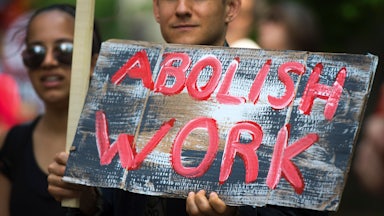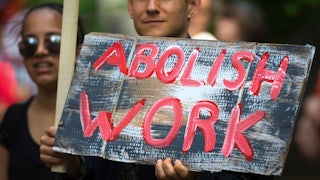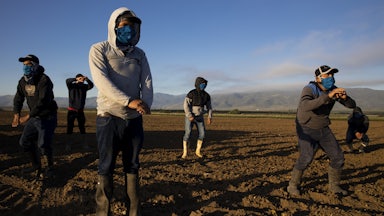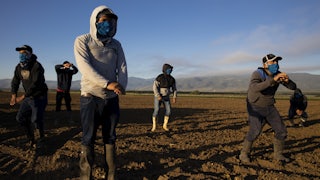In El Salvador, Ingrid Vilorio was a beautician with her own studio. But when her autistic son turned five, she and her husband chose to give up the autonomy of owning a business for a life in the United States. Not knowing how to drive and equipped with only a few words of English, she applied for a job at the first place she saw that was hiring—a McDonald’s down the street from her new home in suburban Alameda County, California.
It was surprisingly brutal work. Ingrid’s shift started around midnight and went until six in the morning. There were never enough people working alongside her, so often she found herself doing the work of two or three people, all by herself. It was a job that required total devotion. “From the moment you work at any restaurant, you don’t know how it will be,” she says. “You become everything that is asked of you, but you think that’s OK.” Since her lack of English prevented her from interacting with customers, she became a regular at the dishwashing station, easily the least-desired role in the kitchen. In the winters, her hands would be frigid, and yet she had to work incessantly to keep an immense pile of dirty cookware from growing any larger. Other times she worked the grill, flipping burgers amid a cacophony of alarms telling the staff when something was ready. “You have to serve burgers in seconds,” she says, snapping her fingers. If she wasn’t fast enough, the manager would yell at her.
“I believe all jobs are difficult,” she says. “But there are jobs where employees are appreciated more than in other jobs.”
Like many service industries, from package fulfillment to retail, fast food has achieved ubiquity in the U.S. through a militant cutting of labor costs—and, perhaps even more importantly, by erasing any sense of worker autonomy. First, companies hire the most vulnerable people in society at the lowest wages possible. (In California, nearly 80 percent of fast-food workers are Black, Asian, or Latino, and more than a quarter are immigrants, many of them undocumented.) Then these companies put them to work in an environment so standardized—and so fast-paced—that any whisper of individuality becomes a liability. Employees start off as people with skills and experiences (not to mention hopes, dreams, and relationships), but they end up as flesh-and-body extensions of the equipment they operate.
The
result is an industry dependent not just on the rationalization of labor but
on the systemic abuse of its workforce. It’s a reality that has been apparent
for years. But now, as the stresses of the pandemic accelerate the pace of the
abuse, fast food is becoming a locus for a labor movement growing more
confident as it extends its list of demands to include a permanent voice in the
halls of power. After years of unions advocating for a higher minimum wage for service
industry workers, Democrats in California’s state assembly are considering a
bold proposal that might actually give fast-food workers their autonomy back.
“Since the pandemic, workers know they need a seat at the table,” says Allynn Umel, the Fight for $15 national coordinator for the Service Employees International Union, or SEIU. Since 2012, the union has backed the Fight for $15—named after its proposed new minimum wage—to organize fast-food workers. During the pandemic alone, Umel says, workers have filed hundreds of complaints with regulators about unsafe conditions, unfair treatment, or both. In one recent survey of Los Angeles County fast-food workers conducted by the UCLA Labor Center, a quarter of respondents said they had complained to a manager. Of those who complained, a quarter faced some form of retaliation, including pay cuts, threats, and harassment.
The litany of complaints, and the tepid response from regulators, has prompted SEIU to throw its weight behind a new bill that could give fast-food workers a permanent voice in government—one that could empower them in workplaces, as well.
If it passes, California’s A.B. 257, commonly known as the “FAST Recovery Act” will create an 11-member “sector council” to set standards for wages, training, and working conditions for fast-food restaurants that are part of a chain of 30 or more locations nationally. While four of the council’s 11 members would come from the state’s health and labor agencies, two seats would be reserved for fast-food workers themselves and two more for worker “advocates,” such as attorneys or union representatives. The last two seats would be reserved for the industry itself: one representative of the fast-food corporations (like the McDonald’s Corporation and Yum! Brands, the parent company of Taco Bell, KFC, and Pizza Hut) and one for the franchisees who own their restaurants. But far from creating a detached observer of industry malpractice, the bill would also require state regulators to take action against any individual company the council found to be in violation of its standards. It’s a model that has precedent in Europe, where “sectoral bargaining” is a common means of securing labor rights for workers within an entire industry, regardless of their employer.
California is a natural place to test a novel approach to regulating fast food. In the postwar years, an affinity for public investment allowed for the lightning-fast conversion of much of the state’s deserts and farmland into suburbia, paving the way for the first restaurant chains dedicated entirely to car-bound customers, including McDonald’s, Carl’s Jr., Taco Bell, In-N-Out, and Jack in the Box—all of which opened their first locations in the state’s newly transformed landscapes. Decades later, a propensity for government involvement now registers in the form of veto-proof Democratic supermajorities in both chambers of the state legislature, which make it possible to enact the kind of ambitious legislation progressives in the U.S. Congress can only dream of. A.B. 257 came up for consideration last year, failing by just three votes, but when an amended version is expected to go up for a vote this week, it is likely to sail through the state assembly. (Per the legislature’s rules, the lower house must vote on the bill by the end of the month for it to be considered this year.) A robust network of activists across California has also made the state a front line for the fast-food labor movement. In 2016, Fight for $15 activists secured the nation’s first statewide $15 minimum wage.
While groundbreaking in national terms, a council to police the fast-food industry wouldn’t be completely out of the norm in technocratic California. As A.B. 257’s backers point out, the state has maintained other councils to monitor threats to coastal waters and guide its energy planning since the 1970s. These bodies serve as platforms for regulators, lawmakers, and subject experts, giving groups time and space to get to know each other, share their worries, and hash out a response. A fast-food industry council would have a similar composition but with workers and their advocates instead of doctorate-holding scientists serving as the resident specialists.
If the bill passes, the hope is that such a council, alongside other, regional councils around the state, could keep regulators apprised of the ever-changing face of abuse in the fast-food industry and hold fast-food companies and their franchisees to account. Giving workers a place to negotiate with the industry would mean they could effectively demand the kinds of basic necessities they are typically denied, such as more security cameras in crime-prone stores and high-quality masks.
Umel says the bill isn’t a departure from the movement’s central ambitions but a realization of its original goals. “It’s always been about giving workers a seat at the table, holding large-scale corporations accountable who have been skirting responsibility and refusing to meet with workers,” she says of Fight for $15. “If progressive lawmakers want to continue to lead the way, they have to stand up for fast-food workers.”
Fast food’s assiduous negation of worker autonomy hardly makes it unique among service sector industries. Amazon is notorious for deploying technologically advanced monitoring systems that penalize warehouse staff for pausing too long between scanning packages and drivers for venturing off their preassigned routes. Walmart has patented surveillance equipment to monitor the sounds of check stands to track employee performance. But the dual-ownership structure that made fast food’s rapid expansion across America possible in the twentieth century has long since given the industry a unique advantage in exploiting its workers. Most fast-food restaurants in America are owned not by the corporations whose names you see in commercials but by independent businesses that carry their likeness under a franchise agreement. The arrangement allows fast-food corporations like McDonald’s Corporation and CKE Restaurants, the parent company of Carl’s Jr. and Hardees, to open new stores without risking their own capital. It also means they can set expectations for those stores’ performance (even unrealistic expectations) while letting the burden of meeting them fall on the franchisees.
In
her own experience working in chronically understaffed kitchens, Ingrid found
that managers harassed employees because they themselves were overwhelmed.
“Mostly, I feel the pressure comes from higher up, because the [franchise]
owners have a lot of pressure on them,” she said. But the pressure only flows
one way: When individual franchisees are caught breaking the law—by, say,
stealing employee wages in a desperate attempt to make up for a slow week—the
corporations to which they’re beholden reliably disavow any association.
Among other things, A.B. 257 is an attempt to narrow that gap in accountability. Not only would it bring fast food’s corporate overlords to the table along with workers and their franchisees, it would also force those big, name-brand companies to share the penalties with their franchisees. But the kind of fine that could bankrupt a small-business owner might barely register for a major corporation like McDonald’s. Another challenge for regulators is that the entire business model has become dependent on the kinds of exploitative practices they are looking to root out. Fast food is about speed (it’s in the name, after all), and ramping it up in recent years has virtually necessitated workplace exploitation.
“A well-run restaurant is like a winning baseball team,” Ray Kroc, the person most responsible for making McDonald’s a national phenomenon, wrote in his 1977 autobiography, Grinding It Out: The Making of McDonald’s. “It makes the most of every crew member’s talents and takes advantage of every split-second opportunity to speed up service.”
Kroc and his contemporaries had few means to accelerate their workers’ pace, other than by hiring energetic young people and yelling at them when they didn’t work fast enough. But with new technology, labor became just another area for speed-obsessed managers to innovate. In her 2019 book, On the Clock: What Low-Wage Work Did to Me and How It Drives America Insane, Emily Guendelsberger, a former newspaper reporter who took a job at a San Francisco McDonald’s for research, writes that she and her colleagues were instructed to fill orders within 60 seconds of tapping them into a cash register.
“Until pretty recently, it was much too difficult to track and enforce guidelines this specific,” she writes. “Today, though, monitoring equipment integrated into the tools workers use to do their jobs can clock and track nearly any task a worker does in real time.” If surveillance alone were not a dehumanizing burden on workers, “those same systems can be set to harass, nag, startle, or otherwise trigger a worker’s stress response every time she lags behind the desired pace.”
Increasing the speed in an environment rich with hot oil, wet floors, and knives makes for jobs that are not just dismal and impersonal but also dangerous and undesirable to anyone except the most desperate people. More than 40 percent of participants in the aforementioned UCLA study said they had endured some kind of workplace injury in the last year alone. The most common injuries, suffered by 29 percent of respondents, were burns. Workers often report being assaulted on the job, as well—an occurrence that’s become more common as they attempt to enforce Covid-19 protocols, such as mask mandates, on their own. “We’ve talked to workers all over the country who want good jobs,” Umel says. “They’re just not willing to work jobs that are dangerous.”
A few months after taking the job at McDonald’s, Ingrid left for a nearby Jack in the Box. When she contracted Covid-19 last March, her new boss refused to use any federal assistance to provide her paid sick leave and forced her to come to work instead, so she sought help from Fight for $15. The experience led her to picket other fast-food restaurants and speak out about her treatment and demonstrate in favor of A.B. 257. Still, she says, she aspires to improve her English enough to leave fast food for good and become a beautician again. “That’s what I studied, and it’s what I did. It’s what I loved,” she says. Until then, she finds other ways to be something more than a fast-food worker, pausing in the rare down moments between orders to look at the people around her and think of the ways she could fix their hair.






